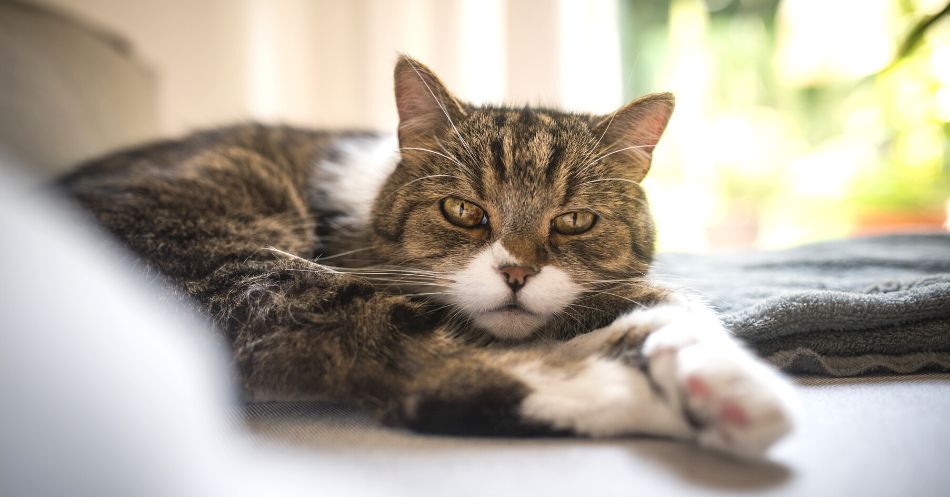
How to Recognize and Control Your Cat’s Osteoarthritis Pain
Cats are masters at disguising their pain – but just because they try to hide it doesn’t mean they don’t experience it intensely. It’s up to us as cat parents to learn these silent and subtle pain signals and get our cats the treatment they need to control their pain – especially when it comes to osteoarthritis (OA).
I recently spoke with Dr. Brian Neumann, Partner, Caring Hands Animal Hospital of Alexandria, VA, about pain in our cats. He explained how to tell if your cat is in pain from feline OA and some of the options that veterinarians have to control pain in cats, so that they can get back to feeling like the cat you know and love.
9 Silent Signals Your Cat Is in Pain
Your cat’s behavior is most normal when they’re at home, not when they’re at the vet’s office. That’s why it’s especially important to pay close attention to potential signs and symptoms of OA pain in your furry friend. As Dr. Neumann said, “We want to be on the lookout for anything that’s different or unusual. You know your cat the best, so you’re going to be the best person to spot these signs.”
When you’re at home, it’s important to observe your cat carefully so you can quickly spot anything out of the ordinary, including these nine silent signs your cat is in pain:1
- Difficulty going up or down the stairs
- Not chasing a ball or playing with toys
- Not running like they used to
- Hesitancy to jump up on surfaces
- Change in mood
- Being less social, or even aggressive toward other animals
- Trouble getting in and out of the litter box, often resulting in eliminating outside the box
- Changes in appearance, like an unkempt coat
- General lethargy, which can be mistaken for a normal sign of aging
These small shifts in behavior could mean that your cat is suffering from OA pain. “Some of these signs are very easy to miss,” Dr. Neumann acknowledged. “For example, if you see your cat slowing down a bit, you might think, ‘Oh, they’re just getting old.’ Maybe, but it very well could be caused by pain.”
Since the signs of OA pain can be quite understated or mistaken for normal behavior, they often aren’t visible in a routine vet visit. Our veterinarians need us pet parents to know our pets and their habits so we can spot these changes and share them with the veterinarian.
Climbing Up
Climbing Down
Chasing Objects
Jumping Up
Jumping Down
Running
©2023 Zoetis Services LLC. All rights reserved. NA-02221R1
Pin Me!
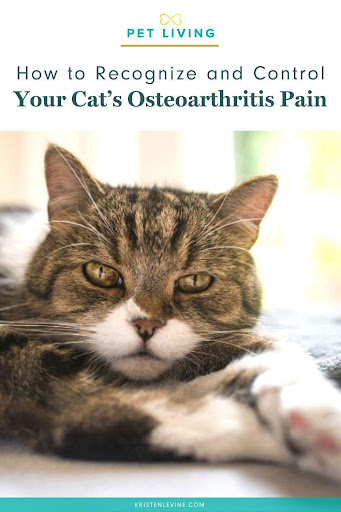
What Is Feline Osteoarthritis?
OA is a common cause of chronic pain in cats.
Dr. Neumann explained what happens in a cat suffering from feline OA. When the cartilage in one of our cat’s joints gets damaged, inflammation happens, which can start a vicious cycle.
“In the beginning,” he explained, “there is inflammation that damages other cells in the cartilage, like the cells that keep the cartilage flexible. When those cells get damaged, other special cells get triggered to help, but that causes even more inflammation, which causes more damage and pain.”
Sadly, if left untreated, this can progress to chronic pain. OA pain is linked to something called NGF, or Nerve Growth Factor, but more on that later.
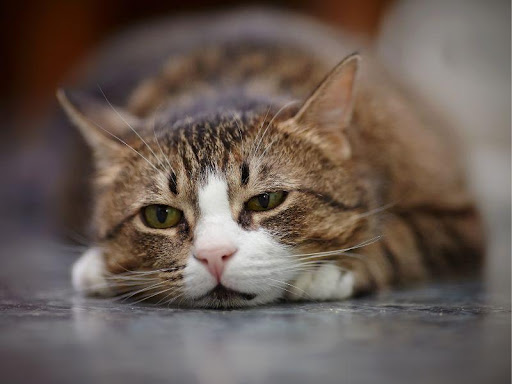
How Common Is Osteoarthritis in Cats?
It’s important to note – while feline OA is common in older cats, it can also occur in very young cats, especially if the joint has been injured.
As many as 40% of all cats show clinical signs of OA pain – in fact, 61% of cats over six years old and 90% of cats over 12 show x-ray evidence of feline osteoarthritis.2,3,4 What’s more, many veterinarians say that OA pain is underrecognized in our cats and, because of that, it’s undertreated. Until very recently, there were no approved treatments for OA pain that gave our cats the relief they so deeply needed. This is why it’s so important for pet parents to be proactive about noticing and keeping track of any changes in their cat’s behavior.
How Is Feline Osteoarthritis in Cats Diagnosed?
If you suspect your cat may have OA, schedule an appointment with your veterinarian. Your vet will take your cat’s history into account and note any injuries or trauma, as well as any changes in behavior.
It’s important to come prepared to your appointment. You can do this by documenting your cat’s behavior when at home, either by journal or (even better) by taking a video when you notice any of the silent signals your cat is in pain.
Dr. Neumann also recommended using this really handy osteoarthritis checklist for cats. He uses it in his own practice and explained that it can “serve as a litmus test for whether or not your cat’s behavior may be concerning.”
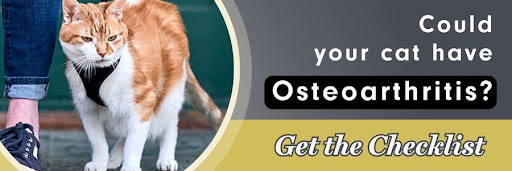
Next, your veterinarian may use several different methods to check your cat’s joints. They will probably observe how your cat moves around the room. They will conduct a thorough physical examination and feel the joints manually, and they may order X-rays or other imaging. They may also order blood work.
If it’s determined your cat is in pain from feline OA, your veterinarian will put together a treatment plan designed to control your cat’s pain.
Using SolensiaTM (frunevetmab injection) to Control OA Pain in Cats
For a long time, anti-inflammatory medications were prescribed to cats with OA pain. The idea is that by controlling the inflammation, you slow down the progression of the disease and ease the cat’s pain. With this in mind, however, NSAIDs are not approved for long-term use in cats in the US – leaving pet owners with an incomplete solution.
However, Dr. Neumann said there’s a new treatment he’s using in his practice. It’s a medication called Solensia.
Speaking to the innovative nature of the treatment, Dr. Neumann said, “Solensia is the first and only FDA-approved treatment to control OA pain in cats to help them regain their quality of life, including increased mobility and overall comfort.”
But what is it exactly?
Dr. Neumann helps explain it.
Remember how we mentioned nerve growth factor (NGF) earlier? Joints affected by OA typically have higher than usual amounts of NGF, setting off a cycle of pain.
Dr. Neumann explained, “You could imagine Solensia like being a sponge to soak up and get rid of a lot of that extra NGF. With less NGF, our cats have less pain. And with less pain, our cats can get back to being happy and enjoying their lives again.”
Solensia is a once-a-month treatment administered by a veterinary professional, which is a big plus. If you’ve ever tried to give your cat daily medication, you know what a nightmare it can be! You both end up stressed, and that definitely affects the relationship you have with your cat. When your cat’s OA pain is controlled, not only are you able to maintain the bond you have with your cat, but your cat may feel more like themselves – and more like the cat that you know and love.
Dr. Neumann shared that he’s been seeing great results in his practice. “I’ve had owners tell me ‘zoomies exist again,’ or that their cat ‘got their purr back.’”
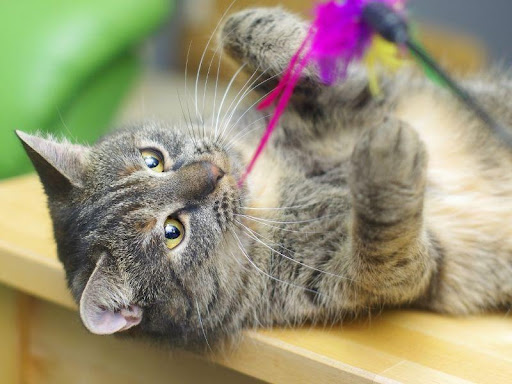
While OA is not curable, Solensia is a great way to effectively control your cat’s pain, so you can continue living happy, active lives together.
In addition to medication, your vet may also recommend some modifications in lifestyle for general wellness.
Lifestyle Tips for Cats with Feline Osteoarthritis
Once your cat has started their treatment program with Solensia, you can make a number of lifestyle changes that will help them get back on their feet and adjust to life with osteoarthritis.
- Make sure your cat can access all their favorite places and things.
When their pain was at its height, you may have modified their environment to make their favorite things more accessible. Once their pain is controlled, you’ll want to encourage them to return to their previous behavior to the extent that it’s comfortable for them. Take note of:
- The location of their food and water dishes
- The height of their litter box
- The ways they access their favorite spots
Cats love their routines, so make sure they can keep their routines despite their OA. Without their routines, stress increases, which can lead to anxiety and a worsening of their pain, which can negatively affect their bond with you.
- Keep your cat at a healthy weight.
Extra weight puts extra strain on sore joints – and it can also lead to further inflammation, which is a key driver of OA pain. Keeping your cat at a healthy weight (or helping them lose a few ounces if needed) limits that strain and the pain that goes with it. Ideal weight varies from cat to cat, so ask your veterinarian what’s right for your furry friend.
- Make sure your cat is getting enough exercise.
This doesn’t mean trying to force your cat to run through the house like they did as a kitten. It means providing ways for your cat to move and play within their abilities.
Encouraging your cat to play and move with toys, puzzles, and easily accessible cat scratchers or towers will help get your cat moving, which will help keep their joints more mobile and their flexibility maintained.

What Happens if You Don’t Control Your Cat’s Osteoarthritis Pain?
Besides not wanting to see our beloved cats in pain, there are additional negative effects to leaving your cat’s OA untreated. Chronic pain like OA can take a horrible toll on your cat and lead to less joy in their lives.
Dr. Neumann stated, “Without treatment, a cat’s quality of life can be impacted. They may not be able to do all the things they love, as the pain worsens over time.”
Decreased activity due to pain can also lead to your cat gaining weight and losing muscle, which makes it even more difficult for them to move around.
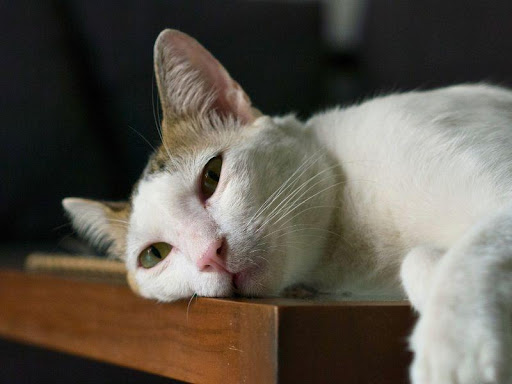
Since the joint damage and pain of OA make them less flexible, many cats with OA start to groom themselves less. This leads to scruffy coats, painful mats, skin irritation, and possibly overgrown nails.
Besides the OA pain itself, it makes your cat more sensitive to pain overall. They may start pulling away when you try to touch them.
They also may be more grumpy and even hide from you. Dr. Neumann added, “Because OA pain can make our cats want to hide or not want to be touched, it really can put a strain on our bond with them.”
The pain also may interfere with their sleep. With less rest and constant stress, it can even harm them mentally and cause cognitive decline.
As you can see, if left untreated, OA dramatically decreases your cat’s quality of life.
That is why it is so important to get our cats diagnosed as soon as possible and start treating their pain effectively.
“When we break that cycle of pain,” said Dr. Neumann, “We don’t just give our cats the joy of being able to move around better again, we get them back to feeling like themselves so they can live their best lives with the people who love them.”
The Tail End
We all know how miserable it is to be in constant pain. While our cats can’t tell us in words how much it hurts, they DO tell us through their behaviors if we know what to look for – meaning it’s up to us to have their backs, to be tuned into their pain signals, and to get them the pain relief they need to get them back to feeling like themselves.
By following our veterinarian’s directions, including keeping our cats at a healthy weight, helping them exercise, and giving them effective prescription medications like Solensia when prescribed, we can help our cats with OA live happy, healthy lives.

IMPORTANT SAFETY INFORMATION: For use in cats only. Women who are pregnant, trying to conceive or breastfeeding should take extreme care to avoid self-injection. Allergic reactions, including anaphylaxis, could potentially occur with self-injection. Solensia should not be used in breeding cats or in pregnant or lactating queens. Solensia should not be administered to cats with known allergy to frunevetmab. The most common adverse events reported in a clinical study were vomiting and injection site pain. See full Prescribing Information.
The animal health information contained herein is provided for educational purposes only and is not intended to replace discussions with an animal healthcare professional. Testimonials represent individual experience only and the experiences and opinions herein may be unique to the patient and the speaker. Individual results may vary considering the unique characteristics of the patient.
Kristen Levine has a consulting relationship with Zoetis.
1 REF: Musculoskeletal Pain Screening Checklist (MiPSC) 2019 North Carolina University.
2 REF: Enomoto, M, et al., Anti-nerve growth factor monoclonal antibodies for the control of pain in dogs and cats. Vet Rec, 2019.
3 REF: Slingerland LI et al, Cross-sectional study of the prevalence and clinical features of osteoarthritis in 100 cats, Vet J. 2011 Mar;187(3):304‑9
4 REF: Lascelles BD, Dong YH, Marcellin-Little DJ, et al. Relationship of orthopedic examination, goniometric measurements, and radiographic signs of degenerative joint disease in cats. BM C Vet Res. 2012;8:10.
SLN-00442





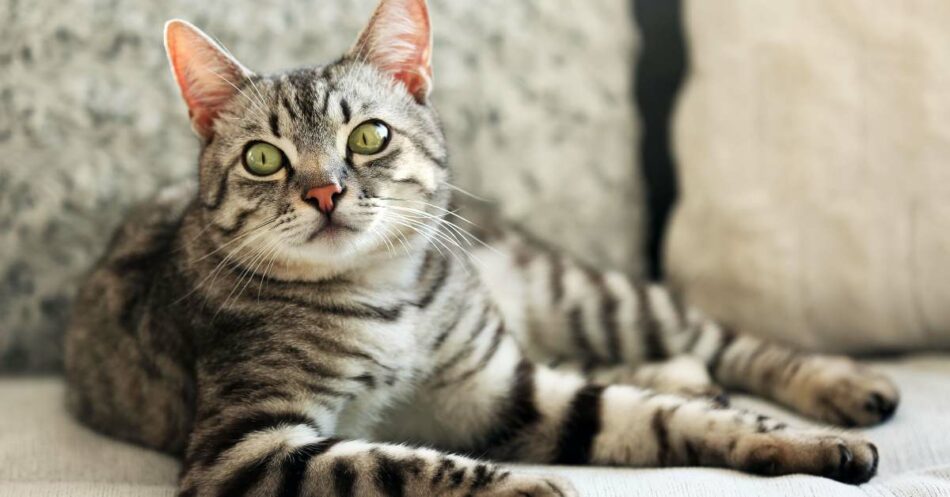

Comments (0)